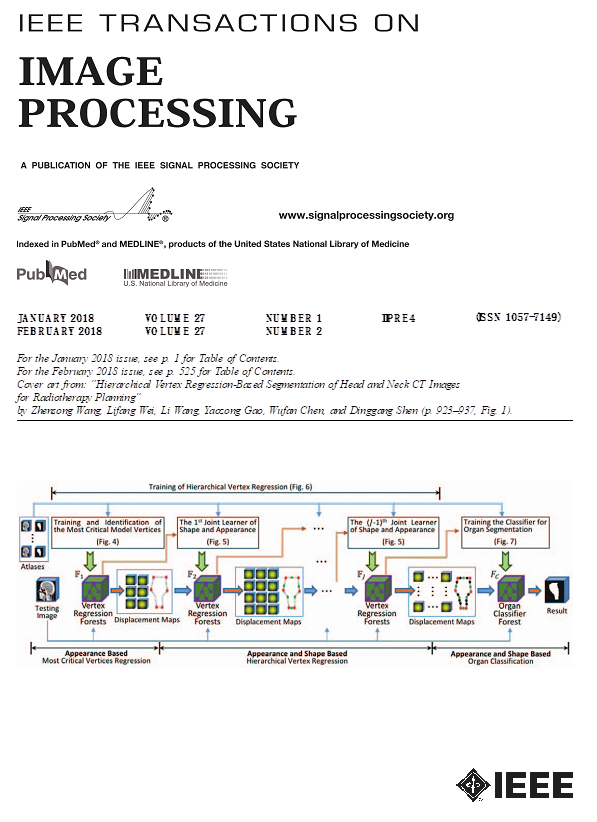跨域少镜头面部表情识别的双曲自定步多专家网络。
IF 13.7
1区 计算机科学
Q1 COMPUTER SCIENCE, ARTIFICIAL INTELLIGENCE
引用次数: 0
摘要
近年来,cross-domain few-shot facial expression recognition (CF-FER)越来越受到人们的关注,该方法是利用源域的基本表情训练模型,在目标域中使用少量图像识别新的复合表情。一般来说,现有的CF-FER方法利用多数据集来增加源域的多样性,减轻源域和目标域之间的差异。然而,这些方法在欧几里得空间中学习特征嵌入,而没有考虑多数据集中不平衡的表达类别和不平衡的样本难度。这种方式使得模型难以捕捉面部表情的层次关系,导致较差的可转移表示。为了解决这些问题,我们提出了一个双曲自定节奏多专家网络(HSM-Net),它包含位于双曲空间的多个专家混合(MoE)层,用于CF-FER。具体来说,HSM-Net以自蒸馏的方式协同训练多个专家,其中每个专家专注于从多数据集中学习表达类别的子集。在此基础上,我们引入了双曲自节奏学习(HSL)策略,利用样本难度从易-难样本中自适应训练模型,大大降低了不平衡表达类别和不平衡样本难度的影响。我们的HSM-Net可以有效地建模丰富的面部表情层次关系,并获得高度可转移的特征空间。在实验室和野外复合表达数据集上进行的大量实验表明,我们提出的方法优于几种最先进的方法。代码将在https://github.com/cxtjl/HSM-Net上发布。本文章由计算机程序翻译,如有差异,请以英文原文为准。
Hyperbolic Self-Paced Multi-Expert Network for Cross-Domain Few-Shot Facial Expression Recognition.
Recently, cross-domain few-shot facial expression recognition (CF-FER), which identifies novel compound expressions with a few images in the target domain by using the model trained only on basic expressions in the source domain, has attracted increasing attention. Generally, existing CF-FER methods leverage the multi-dataset to increase the diversity of the source domain and alleviate the discrepancy between the source and target domains. However, these methods learn feature embeddings in the Euclidean space without considering imbalanced expression categories and imbalanced sample difficulty in the multi-dataset. Such a way makes the model difficult to capture hierarchical relationships of facial expressions, resulting in inferior transferable representations. To address these issues, we propose a hyperbolic self-paced multi-expert network (HSM-Net), which contains multiple mixture-of-experts (MoE) layers located in the hyperbolic space, for CF-FER. Specifically, HSM-Net collaboratively trains multiple experts in a self-distillation manner, where each expert focuses on learning a subset of expression categories from the multi-dataset. Based on this, we introduce a hyperbolic self-paced learning (HSL) strategy that exploits sample difficulty to adaptively train the model from easy-to-hard samples, greatly reducing the influence of imbalanced expression categories and imbalanced sample difficulty. Our HSM-Net can effectively model rich hierarchical relationships of facial expressions and obtain a highly transferable feature space. Extensive experiments on both in-the-lab and in-the-wild compound expression datasets demonstrate the superiority of our proposed method over several state-of-the-art methods. Code will be released at https://github.com/cxtjl/HSM-Net.
求助全文
通过发布文献求助,成功后即可免费获取论文全文。
去求助
来源期刊

IEEE Transactions on Image Processing
工程技术-工程:电子与电气
CiteScore
20.90
自引率
6.60%
发文量
774
审稿时长
7.6 months
期刊介绍:
The IEEE Transactions on Image Processing delves into groundbreaking theories, algorithms, and structures concerning the generation, acquisition, manipulation, transmission, scrutiny, and presentation of images, video, and multidimensional signals across diverse applications. Topics span mathematical, statistical, and perceptual aspects, encompassing modeling, representation, formation, coding, filtering, enhancement, restoration, rendering, halftoning, search, and analysis of images, video, and multidimensional signals. Pertinent applications range from image and video communications to electronic imaging, biomedical imaging, image and video systems, and remote sensing.
 求助内容:
求助内容: 应助结果提醒方式:
应助结果提醒方式:


